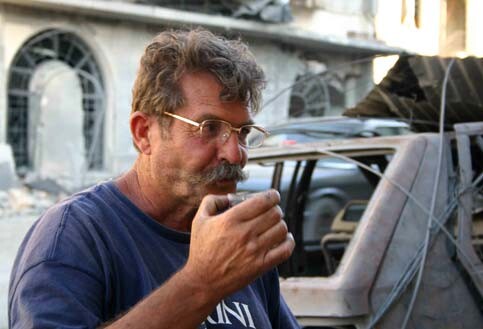IRIN 17 August 2006

Amin Dabaja has sworn to rebuild his home and business, but is not sure how. (IRINNews/Hugh McLeod)
An endless stream of cars filled with families clogs the dusty tracks of southern Lebanon. After the month-long conflict between Israel and the armed wing of Lebanon’s Hezbollah party, displaced civilians are heading home.
Lebanon’s Higher Relief Council says some 200,000 of the one million people it estimates were displaced by the conflict, have hit the road since a United Nations-brokered ceasefire began on Monday. On the journey home, some fly yellow Hezbollah flags from their cars. After driving for 12 hours from Beirut, they reach their villages, or at least what is left of them.
Amin Dabaja and his wife spent 20 days in Bin Jbeil, 10km north of the Lebanon-Israel border and the scene of some of the heaviest Israeli bombardment, under fire before leaving. After their parked car was reduced to a burnt-out shell by an Israeli rocket, the family walked 10km north to Tebnin, and then another 20km north-west to Tyre.
“The street used to have six banks on it. It was the entrance to the city,” said Amin Dabaja, father of seven, on Wednesday as he sipped tea amid the wreckage of his house in Bint Jbeil. He returned on 15 August, the first day of the ceasefire, to find all but one room of his three-storey house destroyed, and his cereals shop reduced to a blackened husk.
His poor eyesight means he does not dare go into what is left of his business for fear of stepping on unexploded ordnance. “Maybe half the townspeople have come back to check their houses, but now most have returned to their shelters again because their homes have been destroyed,” said Dabaja, swatting away the flies around the dead body of an elderly neighbour who had died of a heart attack.
The neighbour’s body had lain uncollected for three weeks until the Lebanese Red Cross (LRC) retrieved it on Monday, the first day of the ceasefire. Thirty-five other elderly people had been pulled from the rubble by LRC volunteers, said Dabaja.
The once bustling main street of Bint Jbeil has been transformed into a confusion of twisted steel cables, shattered glass and thick grey ash. Below the main street, the front wall of a school has been completely blown out, exposing desks and chairs laid out in rows. Walls are pockmarked with shrapnel holes and the town remains without electricity and running water.
“God knows what the future holds,ö said Dabaja. ôI have lost about US $120,000 and I don’t have more money. I have a son in California who can send me some money and I hope I will slowly pick up the pieces. I would like to be able to rebuild and raise our children here in security.”
A few kilometres along the border road, in Aiata al-Shaab, Hezbollah officials, who have begun visiting families to assess the damage, said at least 90 percent of all houses in the village would have to be rebuilt.
Hezbollah’s leader, Hassan Nasrallah, pledged in a speech on 14 August that his organisation would rebuild homes near the southern border destroyed by the war. Where the funds to do this would come from is a source of much speculation.
Amina Baalbeki, a resident of Bazouriye, Nasrallah’s home-town 10km east of Tyre, has mixed feelings about returning. “It was like being brought back to life to see all my loved ones again. But I still feel like someone is missing,” she said of her 75-year-old mother Nazira Birro, who died after being hit in the neck by shrapnel and was buried in a mass grave in Tyre.
The family of nine is living without electricity or water but their home remains relatively undamaged. However, they are still in danger from unexploded ordnance lying around the residential neighbourhood.
“I am not allowing the children to go out, and even I am not going outside,” said Baalbeki, adding that she had heard of a car that set off an unexploded bomb by driving over it. The local mosque has been broadcasting warnings to residents to stay away from unfamiliar objects, and the Lebanese army has been working with Hezbollah officials to detonate ordnance, said Baalbeki.
“We told the kids that anything they find, even if it looks like a toy, they should not pick it up.”
Simon Ingram, communications officer for the United Nations Children’s Agency, said an inter-agency awareness campaign had been launched, distributing leaflets and posters around the 820 internally displaced persons’ centres.
“This is a very serious problem,” Ingram said. “In any area where hostilities have taken place some 10 percent of ordnance remains unexploded. Ammunition shells are left lying around, which, if moved, can explode causing horrific injuries and death. While we understand the need of people to return home they should take every precaution not to touch any suspicious-looking object.”
This item comes to you via IRIN, a UN humanitarian news and information service, but may not necessarily reflect the views of the United Nations or its agencies. All IRIN material may be reposted or reprinted free-of-charge; refer to the copyright page for conditions of use. IRIN is a project of the UN Office for the Coordination of Humanitarian Affairs.
Related Links